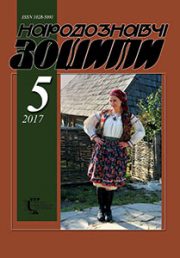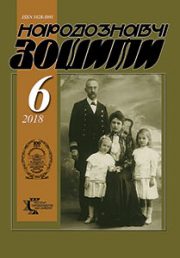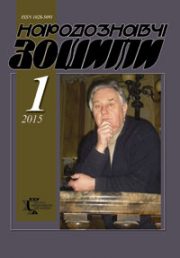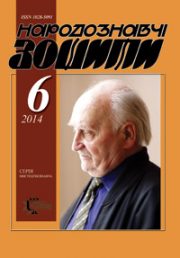The Ethnology Notebooks. 2024. № 1 (175), 42—55
UDK 398.332.4(477.87+438+437.67)
DOI https://doi.org/10.15407/nz2024.01.042
HOLIDAY IN DECEMBER IN LEMKIV REGION
HORBAL Маrіa
- ORCID ID: https://orcid.org/0000-0001-9287-8336
- Leading Scientific Editor,
- The Institute of Ethnology of the National
- Academy of Sciences of Ukraine,
- 15, Svobody Avenue, 79000, Lviv, Ukraine,
- Contacts: e-mail: horbal.m@gmail.com
Abstract. The historical and ethnographic region of Lemkivshchyna was located on the Polish-Ukrainian-Slovak borderland. At the end of the Second World War, the Lemkos were deported from their ancestral lands. Since that time, Lemkas have been spread throughout Ukraine and all over the world. That is why a special place in the study of Lemki culture is occupied by the study of folk customs and rites, which are one of the oldest and most important forms of the spiritual life of Lemki as a component of the Ukrainian ethnos.
The article continues the author’s cycle of folklore and ethnographic publications that relate to the winter rituals of the Lemkiv region.
The topic is relevant, as it has not yet been the subject of detailed scientific consideration in the proposed comprehensive coverage.
The object of the research is the pre-Christmas cycle of holidays in Lemkiv region, and the subject of the research is the structure and local features of religious holidays in December (according to the Julian calendar). The traditions and rites that were held in Lemkivshchyna in the period from the Introduction to Anna are described in detail. The research was written on the basis of the stories of the old residents of Lemkivshchyna, as well as literary sources, which are referred to in the text. In the conclusions, the author notes the high spiritual and Christian consciousness and everyday culture of the Lemki people, created both by the church and by folk traditions.
The entire pre-Christmas cycle, particularly the December holidays, was filled with events and activities where girls and boys were looking for a partner for their future married life. After all, the spring, summer and autumn periods of Lemko life were periods of daily hard work.
The research methodology is based on the application of the principles of historicity, scientific objectivity and structural and typological analysis of folklore and ethnographic artifacts; in the process of studies and scientific qualification of the involved materials, field ethnographic research methods were used, in particular interviewing respondents. A number of considered examples are introduced into scientific circulation for the first time.
Keywords: Catherine, Andrew the First-Called, Naum, Varvara, Nicholas, Anna, saints, temple holiday, polasnik, traditions, rites, events.
Received 3.01.2024
REFERENCES
- Varhol, Yosif. (1991). Folk customs of the winter period. Lemki national calendar for 1988—1991 (Pp. 71—76). Retrieved from: http://lemko.org/pdf/KLS1991.pdf [in Ukrainian].
- Ardan, Volodymyr. (2011). My native Polyany. Touches to the history of the village. Lviv [in Ukrainian].
- Holy Great Martyr Varvara in Ukrainian old prints. Retrieved from: http://www.nbuv.gov.ua/node/5584 [in Ukrainian].
- Obituary. Retrieved from: http://pc.studyty.org.ua/content/blogsection/10/15/ [in Ukrainian].
- Puliy, Ivan, & Shenderovskyi, Vasyl. (Ed). (1997). Collection of works. (Vol. III). Prayer book. Psalter. Reprint: Prayer book for the Russian people. Second enlarged edition. Vienna, 1871. Kyiv: Rada [in Ukrainian].
- Horbal, Maria. (Ed.). (2004). Christmas in Lemkivshchyna. Folklore and ethnographic research. Lviv: Institute of Ethnology of the National Academy of Sciences of Ukraine [in Ukrainian].
- Horbal, Maria. (Ed.). (2009). Christmas tree. Lemki Christmas legends and tales. Lviv: Institute of Ethnology of the National Academy of Sciences of Ukraine [in Ukrainian].
- Gorbal, Maria. (2011). Christmas rituals of Lemkivshchyna: monograph. Lviv: Institute of Ethnology of the National Academy of Sciences of Ukraine [in Ukrainian].
- Gorbal, Maria. (2019). Lemki «vechirky» («vechyrky», «vechurky», «pryadky»). Lviv: Institute of Ethnology of the National Academy of Sciences of Ukraine [in Ukrainian].
- Shmayda, Mykhailo. (1992). I congratulate you. Calendar rites of the Ruthenians-Ukrainians of Czecho-Slovakia (Vol. 1). Bratislava; Pryashiv [in Ukrainian].
- Syvytskyi, Mykola. (1988). Andrew Lemkivshchyna Earth. People. History. Culture (Part II). New York; Paris; Sydney; Toronto [in Ukrainian].
- Traditions and omens of Ukrainians during December holidays. Retrieved from: https://uaua.top/5309/?utm_source=facebook&utm_medium=urkfb&utm_campaign=gruden&fbclid=IwAR2p48h_IObXc7CvXQHzntSzmgynvsqQscTDmv7UNWR_dgKb5VWUuumeH18 [in Ukrainian].
- Protoevangelium of James. Retrieved from: http://kyiv-pravosl.info/2022/01/10/protoevanhelie-yakova/ [in Ukrainian].
- God’s law. (1996). Textbook for family and school. Kyiv: Fantasy LTD [in Ukrainian].
- Holidays in December: traditions, omens and divination. Retrieved from: https://archive.svitua.org/item/8131-sviata-u-hrudni-tradytsii-prykmety-i-vorozhinnia.html [in Ukrainian].
- Krasovsky, Ivan. (1993). Surnames of Galician Lemkos in the 18th century. Based on the materials of the Josephine Land Cadastre of 1787—1788. Lviv [in Ukrainian].







